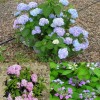 Discoveries of reflowering hydrangeas have resulted in the introduction of many new cultivars, providing more garden impact and strengthening ongoing hydrangea appreciation. Even prior to the new reflowering cultivars, gardeners and landscapers had renewed interest in hydrangeas because they flower in shade, often produce blue flowers, and are considered an “heirloom” plant that reminds us of the garden heritage of our forefathers. Many of the newer cultivars have superior form and disease resistance, and some provide 15 or more weeks of flowering per year in north Florida. This 5-page fact sheet was written by Gary W. Knox, and published by the UF Department of Environmental Horticulture, September 2012.
Discoveries of reflowering hydrangeas have resulted in the introduction of many new cultivars, providing more garden impact and strengthening ongoing hydrangea appreciation. Even prior to the new reflowering cultivars, gardeners and landscapers had renewed interest in hydrangeas because they flower in shade, often produce blue flowers, and are considered an “heirloom” plant that reminds us of the garden heritage of our forefathers. Many of the newer cultivars have superior form and disease resistance, and some provide 15 or more weeks of flowering per year in north Florida. This 5-page fact sheet was written by Gary W. Knox, and published by the UF Department of Environmental Horticulture, September 2012.
http://edis.ifas.ufl.edu/ep287
Category: Lawn & Garden
Tabebuia serratifolia, Yellow Trumpet Tree (FOR303/FR371)
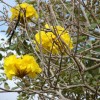 This deciduous tree is native to South and Central America is commonly planted in Florida as an ornamental landscape and shade tree. It has attractive bright, yellow blossoms produced in the absence of leaves. Once established, this tree is drought tolerant, making it easier to care for and less demanding on water resources. Yellow trumpet tree also has a relatively high tolerance to salt spray, and therefore is an appropriate street tree or yard specimen in coastal areas.This 2-page fact sheet was written by Michael G. Andreu, Melissa H. Friedman, and Robert J. Northrop, and published by the UF Department of School of Forest Resources and Conservation, July 2012.
This deciduous tree is native to South and Central America is commonly planted in Florida as an ornamental landscape and shade tree. It has attractive bright, yellow blossoms produced in the absence of leaves. Once established, this tree is drought tolerant, making it easier to care for and less demanding on water resources. Yellow trumpet tree also has a relatively high tolerance to salt spray, and therefore is an appropriate street tree or yard specimen in coastal areas.This 2-page fact sheet was written by Michael G. Andreu, Melissa H. Friedman, and Robert J. Northrop, and published by the UF Department of School of Forest Resources and Conservation, July 2012.
http://edis.ifas.ufl.edu/fr371
Hippomane mancinella, Manchineel (FOR302/FR370)
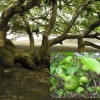 This poisonous tree is native to southern Florida, the Keys, many of the Caribbean islands, Mexico, and Central America. Though it is poisonous to humans and many animals, iguanas are eat the fruit and sometimes live among the tree’s limbs. It’s found along the seacoasts and in brackish swamps where it grows among mangroves. Each leaf has a small gland where the leaf joins the stem. The bark is reddish-to-grayish brown and cracked looking. Flowers inconspicuous, but the spikes or leafless stems that the flowers emerge from are visible. The fruit is bright-green and looks like a small apple. This 2-page fact sheet was written by Michael G. Andreu and Melissa H. Friedman, and published by the UF Department of School of Forest Resources and Conservation, July 2012.
This poisonous tree is native to southern Florida, the Keys, many of the Caribbean islands, Mexico, and Central America. Though it is poisonous to humans and many animals, iguanas are eat the fruit and sometimes live among the tree’s limbs. It’s found along the seacoasts and in brackish swamps where it grows among mangroves. Each leaf has a small gland where the leaf joins the stem. The bark is reddish-to-grayish brown and cracked looking. Flowers inconspicuous, but the spikes or leafless stems that the flowers emerge from are visible. The fruit is bright-green and looks like a small apple. This 2-page fact sheet was written by Michael G. Andreu and Melissa H. Friedman, and published by the UF Department of School of Forest Resources and Conservation, July 2012.
http://edis.ifas.ufl.edu/fr370
Fortunella spp., Kumquat (FOR300/FR368)
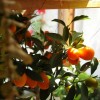 Many people find kumquat trees attractive and useful yard specimens. Their dark green leaves and contrasting bright orange fruits give them ornamental quality, and their relatively small size makes them easy to care for once they’re established. Because kumquats generally require less care than other citrus trees, they may be a good choice for gardeners with less time or experience, but who still desire an attractive and tasty citrus tree. If space is an issue, kumquats also do well in containers as long as they receive proper sunlight and watering. This 2-page fact sheet was written by Michael G. Andreu, Melissa H. Friedman, and Robert J. Northrop, and published by the UF Department of School of Forest Resources and Conservation, July 2012.
Many people find kumquat trees attractive and useful yard specimens. Their dark green leaves and contrasting bright orange fruits give them ornamental quality, and their relatively small size makes them easy to care for once they’re established. Because kumquats generally require less care than other citrus trees, they may be a good choice for gardeners with less time or experience, but who still desire an attractive and tasty citrus tree. If space is an issue, kumquats also do well in containers as long as they receive proper sunlight and watering. This 2-page fact sheet was written by Michael G. Andreu, Melissa H. Friedman, and Robert J. Northrop, and published by the UF Department of School of Forest Resources and Conservation, July 2012.
http://edis.ifas.ufl.edu/fr368
Gleditsia aquatica, Water Locust (FOR301/FR369)
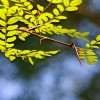 Water locust’s wide, spreading root system and affinity for hydric conditions makes it a useful specimen for erosion control on wet banks of freshwater systems. While not widely available, planting this tree in residential yards or other public locations may be less than ideal, since the long and sharply pointed thorns on the main trunk and branches can be hazardous. This deciduous tree is native to Florida. This 2-page fact sheet was written by Michael G. Andreu, Melissa H. Friedman, and Robert J. Northrop, and published by the UF Department of School of Forest Resources and Conservation, July 2012.
Water locust’s wide, spreading root system and affinity for hydric conditions makes it a useful specimen for erosion control on wet banks of freshwater systems. While not widely available, planting this tree in residential yards or other public locations may be less than ideal, since the long and sharply pointed thorns on the main trunk and branches can be hazardous. This deciduous tree is native to Florida. This 2-page fact sheet was written by Michael G. Andreu, Melissa H. Friedman, and Robert J. Northrop, and published by the UF Department of School of Forest Resources and Conservation, July 2012.
http://edis.ifas.ufl.edu/fr369
Callistemon salignus, White Bottlebrush (FOR292/FR360)
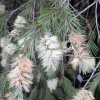 Native to Australia, this evergreen tree has use as an ornamental tree that produces moderate shade along a street, median, or yard. The unique flowering structure is eye-catching and it can be pruned for use as a decorative hedge. Its tolerance of many different soil types and droughty conditions makes it easy to care for after it’s been established. This 2-page fact sheet was written by Michael Andreu, Melissa Friedman, Robert Northrop, and published by the UF Department of School of Forest Resources and Conservation, July 2012.
Native to Australia, this evergreen tree has use as an ornamental tree that produces moderate shade along a street, median, or yard. The unique flowering structure is eye-catching and it can be pruned for use as a decorative hedge. Its tolerance of many different soil types and droughty conditions makes it easy to care for after it’s been established. This 2-page fact sheet was written by Michael Andreu, Melissa Friedman, Robert Northrop, and published by the UF Department of School of Forest Resources and Conservation, July 2012.
http://edis.ifas.ufl.edu/fr360
Cassia grandis, Pink Shower (FOR294/FR362)
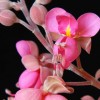 The name “pink shower” comes from the bright pink blossoms that this tree produces. It is sometimes called “stinking tree” because the pulp in its pods has a very strong smell. This 2-page fact sheet was written by Michael G. Andreu, Melissa H. Friedman, and Robert J. Northrop, and published by the UF Department of School of Forest Resources and Conservation, July 2012.
The name “pink shower” comes from the bright pink blossoms that this tree produces. It is sometimes called “stinking tree” because the pulp in its pods has a very strong smell. This 2-page fact sheet was written by Michael G. Andreu, Melissa H. Friedman, and Robert J. Northrop, and published by the UF Department of School of Forest Resources and Conservation, July 2012.
http://edis.ifas.ufl.edu/fr362
Cassia leptophylla, Gold Medallion Tree (FOR295/FR363)
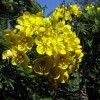 The gold medallion tree is planted primarily as a shade tree or as a decorative specimen for the yard or street. Many people like this tree because of its fast growth rate and showy, bright yellow clusters of flowers that bloom in the summer months. This tree loses its leaves for a very short period each year, but leaves are quickly replaced. Pruning the tree to one main leading stem from which major branches are attached can help increase its strength and sturdiness against strong wind events. The golden medallion tree is also naturally pest resistant, and as long as it is grown in areas where the temperature does not drop below freezing, it is an easy tree to care for. This 2-page fact sheet was written by Michael G. Andreu, Melissa H. Friedman, and Robert J. Northrop, and published by the UF Department of School of Forest Resources and Conservation, July 2012.
The gold medallion tree is planted primarily as a shade tree or as a decorative specimen for the yard or street. Many people like this tree because of its fast growth rate and showy, bright yellow clusters of flowers that bloom in the summer months. This tree loses its leaves for a very short period each year, but leaves are quickly replaced. Pruning the tree to one main leading stem from which major branches are attached can help increase its strength and sturdiness against strong wind events. The golden medallion tree is also naturally pest resistant, and as long as it is grown in areas where the temperature does not drop below freezing, it is an easy tree to care for. This 2-page fact sheet was written by Michael G. Andreu, Melissa H. Friedman, and Robert J. Northrop, and published by the UF Department of School of Forest Resources and Conservation, July 2012.
http://edis.ifas.ufl.edu/fr363
Cassia afrofistula, Kenyan Cassia (FOR296/FR364)
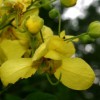 The Kenyan cassia can be used as a showy ornamental tree or shrub, with its dark foliage and bright yellow flowers. Some people find the seed pods to be unattractive and prune the tree after it flowers to prevent pods from developing. This tree tolerates a wide range of soil types and can be used in a garden, park, patio, or streetscape setting. This 2-page fact sheet was written by Michael G. Andreu, Melissa H. Friedman, and Robert J. Northrop, and published by the UF Department of School of Forest Resources and Conservation, July 2012.
The Kenyan cassia can be used as a showy ornamental tree or shrub, with its dark foliage and bright yellow flowers. Some people find the seed pods to be unattractive and prune the tree after it flowers to prevent pods from developing. This tree tolerates a wide range of soil types and can be used in a garden, park, patio, or streetscape setting. This 2-page fact sheet was written by Michael G. Andreu, Melissa H. Friedman, and Robert J. Northrop, and published by the UF Department of School of Forest Resources and Conservation, July 2012.
http://edis.ifas.ufl.edu/fr364
Leucaena leucocephala, White Leadtree (FOR299/FR367)
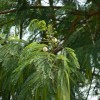 In Florida, white leadtree is a prohibited species and therefore is not used in commercial applications in the state. However, in its native range it is used as a source of charcoal, fuel, and lumber. It has also been planted as a windbreak for crops such as coffee and cocoa, and some ranchers use the tree as a source of both shade and forage for cattle, with the pods being an excellent source of protein. In addition, as white leadtree forms a well-developed taproot, it has been planted to assist with erosion control. This 2-page fact sheet was written by Michael G. Andreu, Melissa H. Friedman, and Robert J. Northrop, and published by the UF Department of School of Forest Resources and Conservation, July 2012.
In Florida, white leadtree is a prohibited species and therefore is not used in commercial applications in the state. However, in its native range it is used as a source of charcoal, fuel, and lumber. It has also been planted as a windbreak for crops such as coffee and cocoa, and some ranchers use the tree as a source of both shade and forage for cattle, with the pods being an excellent source of protein. In addition, as white leadtree forms a well-developed taproot, it has been planted to assist with erosion control. This 2-page fact sheet was written by Michael G. Andreu, Melissa H. Friedman, and Robert J. Northrop, and published by the UF Department of School of Forest Resources and Conservation, July 2012.
http://edis.ifas.ufl.edu/fr367
Forest Management in the Interface: Reducing Fire Risk (FOR179/FR249)
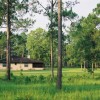 Wildfire is one of the most serious and publicized challenges facing interface forest management. Wildfires can change forest vegetation, affect human health, and cause millions of dollars’ worth of damage to homes, businesses, timber, and tourism. This 5-page fact sheet outlines tips for the firewise community development, design of structures, landscaping and fuel reduction. Written by Bruce Hull, Sarah F. Ashton, Rien M. Visser, and Martha C. Monroe, and published by the UF Department of School of Forest Resources and Conservation, August 2012.
Wildfire is one of the most serious and publicized challenges facing interface forest management. Wildfires can change forest vegetation, affect human health, and cause millions of dollars’ worth of damage to homes, businesses, timber, and tourism. This 5-page fact sheet outlines tips for the firewise community development, design of structures, landscaping and fuel reduction. Written by Bruce Hull, Sarah F. Ashton, Rien M. Visser, and Martha C. Monroe, and published by the UF Department of School of Forest Resources and Conservation, August 2012.
http://edis.ifas.ufl.edu/fr249
Landscaping in Florida with Fire in Mind (FOR71/FR076)
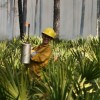 Fire is a powerful part of Florida’s landscape. It can maintain healthy natural ecosystems (Figure 1), but can also turn a home to ashes. Florida’s frequent lightning strikes and human carelessness guarantee that wildfire will continue to be a factor in both rural and suburban areas. Some homeowners may wonder if they are in danger of wildfire. Find out if you are at risk, and follow these guidelines to reduce the threat of wildfire. This 4-page fact sheet was written by Martha Monroe, Alan Long, and published by the UF Department of School of Forest Resources and Conservation, September 2012.
Fire is a powerful part of Florida’s landscape. It can maintain healthy natural ecosystems (Figure 1), but can also turn a home to ashes. Florida’s frequent lightning strikes and human carelessness guarantee that wildfire will continue to be a factor in both rural and suburban areas. Some homeowners may wonder if they are in danger of wildfire. Find out if you are at risk, and follow these guidelines to reduce the threat of wildfire. This 4-page fact sheet was written by Martha Monroe, Alan Long, and published by the UF Department of School of Forest Resources and Conservation, September 2012.
http://edis.ifas.ufl.edu/fr076
Cassia javanica, Pink and White Shower (FOR297/FR365)
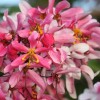 Cassia javanica is planted primarily as a decorative shade tree. Many people consider pink and white shower to be aesthetically pleasing because of its pink and white blooms that emerge during the summer months. Because its leafless season is so short, it can be a good shade tree throughout the year. Its rapid growth rate makes it an ideal tree for homeowners looking to increase their tree cover. And its natural resistance to pests increases its desirability as a landscape tree that is commonly used as an ornamental street tree. This 2-page fact sheet was written by Michael G. Andreu, Melissa H. Friedman, and Robert J. Northrop, and published by the UF Department of School of Forest Resources and Conservation, July 2012.
Cassia javanica is planted primarily as a decorative shade tree. Many people consider pink and white shower to be aesthetically pleasing because of its pink and white blooms that emerge during the summer months. Because its leafless season is so short, it can be a good shade tree throughout the year. Its rapid growth rate makes it an ideal tree for homeowners looking to increase their tree cover. And its natural resistance to pests increases its desirability as a landscape tree that is commonly used as an ornamental street tree. This 2-page fact sheet was written by Michael G. Andreu, Melissa H. Friedman, and Robert J. Northrop, and published by the UF Department of School of Forest Resources and Conservation, July 2012.
http://edis.ifas.ufl.edu/fr365
Pepper Fruit Fly Atherigona orientalis (Schiner) (Insecta: Diptera: Muscidae) (EENY539/IN948)
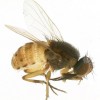 Although it is commonly referred to as the pepper fruit fly or tomato fruit fly, Atherigona orientalis is not a true fruit fly in the family Tephritidae, but rather a member of the Muscidae, the same family to which the common house fly belongs. It is found in most tropical and subtropical areas of the world and is usually considered a secondary pest or “trash fly.” But it can sometimes be a primary pest of certain agricultural crops, most notably plants in the family Solanaceae. This 4-page fact sheet was written by Kenneth L. Hibbard and William A. Overholt, and published by the UF Department of Entomology and Nematology, September 2012.
Although it is commonly referred to as the pepper fruit fly or tomato fruit fly, Atherigona orientalis is not a true fruit fly in the family Tephritidae, but rather a member of the Muscidae, the same family to which the common house fly belongs. It is found in most tropical and subtropical areas of the world and is usually considered a secondary pest or “trash fly.” But it can sometimes be a primary pest of certain agricultural crops, most notably plants in the family Solanaceae. This 4-page fact sheet was written by Kenneth L. Hibbard and William A. Overholt, and published by the UF Department of Entomology and Nematology, September 2012.
http://edis.ifas.ufl.edu/in948
Spring Viremia of Carp (VM142/VM106)
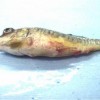 Spring viremia of carp is a viral disease that can cause significant mortality in several carp species including the common carp. It was reported in koi and feral carp in the United States for the first time in 2002. Diagnosis in farm raised fish in the U.S. may result in quarantine of the infected fish and depopulation. This 5-page fact sheet is intended to inform veterinarians, biologists, culturists, and hobbyists about Spring viremia of carp. Written by Barbara D. Petty, Ruth Francis-Floyd, and Roy P.E. Yanong, and published by the UF Department of Fisheries and Aquatic Sciences, August 2012.
Spring viremia of carp is a viral disease that can cause significant mortality in several carp species including the common carp. It was reported in koi and feral carp in the United States for the first time in 2002. Diagnosis in farm raised fish in the U.S. may result in quarantine of the infected fish and depopulation. This 5-page fact sheet is intended to inform veterinarians, biologists, culturists, and hobbyists about Spring viremia of carp. Written by Barbara D. Petty, Ruth Francis-Floyd, and Roy P.E. Yanong, and published by the UF Department of Fisheries and Aquatic Sciences, August 2012.
http://edis.ifas.ufl.edu/vm106
Hurricane-Damaged Palms in the Landscape: Care after the Storm (ENH1204/EP465)
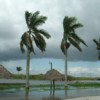 While many palm species are adapted to windstorms, a hurricane can damage even the most tolerant palms. This 3-page fact sheet provides suggestions about what to do after a windstorm has occurred once it is safe to venture outside to care for the landscape.
While many palm species are adapted to windstorms, a hurricane can damage even the most tolerant palms. This 3-page fact sheet provides suggestions about what to do after a windstorm has occurred once it is safe to venture outside to care for the landscape.
Written by Monica L. Elliott and Timothy Broschat, and published by the UF Department of Environmental Horticulture, September 2012.
http://edis.ifas.ufl.edu/ep465
UF-T3 and UF-T4: Two Sterile Lantana camara Varieties (ENH1202/EP463)
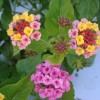 Lantana camara plants are valued for their bright flower color, butterfly attraction, tolerance to harsh environmental conditions, low maintenance requirements, and ease of propagation and production. But many existing varieties can be weedy or invasive when grown in tropical and subtropical regions. So in 2004, UF/IFAS started a program to develop sterile L. camara varieties with little to no invasive potential.
Lantana camara plants are valued for their bright flower color, butterfly attraction, tolerance to harsh environmental conditions, low maintenance requirements, and ease of propagation and production. But many existing varieties can be weedy or invasive when grown in tropical and subtropical regions. So in 2004, UF/IFAS started a program to develop sterile L. camara varieties with little to no invasive potential.
This 8-page fact sheet introduces the recently released UF-T3 and UF-T4 lantana varieties that have resulted from these breeding, selection, and testing efforts. Written by Zhanao Deng, David M. Czarnecki II, Sandra B. Wilson, Gary W. Knox, and Rosanna Freyre, and published by the UF Department of Environmental Horticulture, August 2012.
http://edis.ifas.ufl.edu/ep463
Earthworm, suborder Crassiclitellata, cohort Terrimegadrili (Jamieson, 1988) (EENY532/IN946)
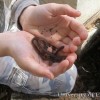 Like insects, earthworms are among the animals most frequently encountered by many Floridians. Our kids play with them, dissect them in middle school biology, we fish with them, they crawl across our sidewalks and live in our flower pots. Despite this, their ecological and economic importance often goes unrecognized. Earthworms have several important ecological roles. Additionally, some species are used commercially for bait, animal feed, environmental remediation, and composting. This 6-page fact sheet was written by William T. Crow, and published by the UF Department of Entomology and Nematology, September 2012.
Like insects, earthworms are among the animals most frequently encountered by many Floridians. Our kids play with them, dissect them in middle school biology, we fish with them, they crawl across our sidewalks and live in our flower pots. Despite this, their ecological and economic importance often goes unrecognized. Earthworms have several important ecological roles. Additionally, some species are used commercially for bait, animal feed, environmental remediation, and composting. This 6-page fact sheet was written by William T. Crow, and published by the UF Department of Entomology and Nematology, September 2012.
http://edis.ifas.ufl.edu/in946
Fusarium Wilt of Canary Island Date Palm (PP215/PP139)
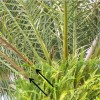 As the name implies, Fusarium wilt of Canary Island date palm is primarily observed on the Canary Island date palm. It was first documented in the United States in the 1970s in California, but it was not documented in Florida until 1994. It now occurs throughout the state. The fungus obstructs the xylem (water-conducting) tissue, which results in desiccation and death. This 5-page fact sheet was written by Monica L. Elliott, and published by the UF Department of Plant Pathology, July 2012.
As the name implies, Fusarium wilt of Canary Island date palm is primarily observed on the Canary Island date palm. It was first documented in the United States in the 1970s in California, but it was not documented in Florida until 1994. It now occurs throughout the state. The fungus obstructs the xylem (water-conducting) tissue, which results in desiccation and death. This 5-page fact sheet was written by Monica L. Elliott, and published by the UF Department of Plant Pathology, July 2012.
http://edis.ifas.ufl.edu/pp139
Design Considerations for a Florida-Friendly Demonstration Landscape: A Case Study for Student and Extension Volunteer Involvement (ENH1199/EP460)
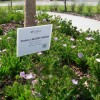 Landscape design students in the Environmental Horticulture Department at the University of Florida participated in the planning and design of the landscape for a new professional development center on the university campus. Such large-scale projects provide a unique experiential learning activity for students and volunteers in landscape design and horticulture programs. This 6-page fact sheet was written by Gail Hansen and Brian Niemann, and published by the UF Department of Environmental Horticulture, August 2012.
Landscape design students in the Environmental Horticulture Department at the University of Florida participated in the planning and design of the landscape for a new professional development center on the university campus. Such large-scale projects provide a unique experiential learning activity for students and volunteers in landscape design and horticulture programs. This 6-page fact sheet was written by Gail Hansen and Brian Niemann, and published by the UF Department of Environmental Horticulture, August 2012.
http://edis.ifas.ufl.edu/ep460